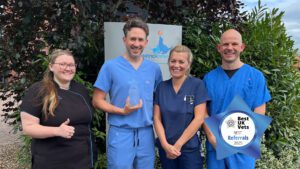Objective
To report the development of a measurement method for quantifying ulnar subtrochlear sclerosis (STS) in Labrador Retrievers.
Study design
Prospective blinded study.
Animals
Radiographs of Labrador Retrievers elbows (n=30) with minimal radiographic signs of periarticular osteophytosis.
Methods
Measurement of STS as a % of the distance between 2 standardized radiographic landmarks (%STS) was developed. Mediolateral radiographic projections of flexed elbows were collected from 2 cohorts termed diseased (n=15; confirmed disease of the medial coronoid process) and control (n=15; free from clinically evident disease). Five observers blindly assessed each radiograph for radiographic technique, elbow positioning, periarticular osteophytosis, and STS, which, if present, was measured and assigned a %STS score. Intraobserver and interobserver variations in measuring STS and the ability to differentiate study cohorts were assessed using receiver operator curve (ROC) characteristics. A P-value of
Results
Median %STS for diseased elbows was 47% (range, 0-74%) and 0% (range, 0-62%) for control elbows. Correlations were not significantly different between each observer's assessments of %STS, with a median Spearman's P-value of .75 (range, .67-.86). All observers differentiated the 2 cohorts with "fair-good" accuracy, with a median ROC value of 0.81 (range, 0.75-0.88).
Conclusion
Measurement of %STS in Labrador Retrievers was repeatable for each observer and repeatable between observers.
Clinical relevance
A method for measuring STS allows comparison of Labrador Retrievers of different sizes, is easy to perform, and could be used to investigate the clinical significance of STS in this breed.







